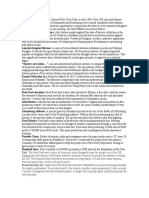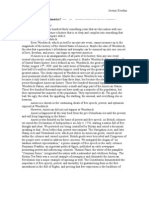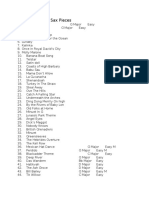APUSH Culture Chart: Reformers in Education
APUSH Culture Chart: Reformers in Education
Uploaded by
CandiceRadCopyright:
Available Formats
APUSH Culture Chart: Reformers in Education
APUSH Culture Chart: Reformers in Education
Uploaded by
CandiceRadOriginal Description:
Original Title
Copyright
Available Formats
Share this document
Did you find this document useful?
Is this content inappropriate?
Copyright:
Available Formats
APUSH Culture Chart: Reformers in Education
APUSH Culture Chart: Reformers in Education
Uploaded by
CandiceRadCopyright:
Available Formats
Alkalay, Talia (P. 4) Badri, Yassaman (P. 6) Kamranikia, Mona (P. 6) Shahandeh-Rad, Candice (P.
5)
APUSH Culture Chart
Reformers in Education John Dewey: John Dewey is claimed to be The Father of Modern Education because of the changes he made to education in the 1920s. Dewey backed his proposals to education with Darwins theory of Evolution. His first theory is based on Pragmatism, the process of learning from doing. Earlier methods of education focused on repetition, routine, and authoritarian learning. Thus, Dewey proposed to make schools more attractive by changing schools to teach practical skills, and participation in classroom activity. The Scopes Trial: The major conflict of school boards during this era was the separation of church and state. With the newly developing idea of evolution, science teachers across America were divided on teaching about Evolution or not. The Scopes Monkey Trial, which took place in 1925, was famous for purposely breaking the Tennessee Butler Law preventing a teacher from teaching about evolution. John Thomas Scopes, a modernist, argued that evolution was consistent with religion, but was eventually guilty and fined 100 dollars. The case proved that regardless of how the trial proved that no matter how the facts of the case were proven; the outcome was already settled by personal beliefs.
Sciences and Technology
Barbed Wire: Barbed wire was invented in Illinois to help control animals. In World War I, it was often used to ward off the enemy and protect sites. Powered Vacuum Cleaner: Hubert C. Booth invented the first powered vacuum cleaner in 1901. He thought of it while
trying to suck in dust through a handkerchief. This revolutionized the process of cleaning carpets. Airplanes: Orville and Wilbur Wright invented the first successful airplane in 1903.Their system of three axis control was revolutionary. This was a huge breakthrough at the time, and aircrafts were essential just a few years later for World War I. Theory of General Relativity: Albert Einstein published a paper in 1916 discussing the theory of relativity, which led to the modern understanding of physics and the universe. Albert also came up with the equation e=m x c squared. Quantum physics would not be the same without his observations and discoveries. Tea Bags: The first tea bags were created and used in 1904 by Thomas Sullivan, a merchant in New York. William Hermanson invented the paper teabag later. Zipper: Gideon Sundback invented the modern zipper in 1913, based on the concept of teeth. Ford Model T: The first Ford model T was invented in 1908 by Henry Fords motor company. The fastest it could go was about 45 miles per hour. This allowed commoners to begin purchasing automobiles, as it was much more affordable, since it was produced on a production line which reduced costs. Sonar: Lewis Nixon invented the first sonar in 1906. It is a crucial instrument to detect submarines.
Achievements in the Arts and Culture
Music: One of the greatest contributions to American culture was sudden musical interest in Jazz music. From the end of
World War I to the emergence of the great depression in 1929 jazz music had such a huge impact in American culture that this period of time became known as the Jazz Age Although the older generations believed jazz music was immortal and distasteful, jazz music became largely popular in the United States. Jazz music originally began in New Orleans and then soon later became popular in the United States due to African American migration after World War one. Originally, jazz bands consisted of black musicians such as Handy, Morton, and Joseph however; white bands such as Paul Whitemans dominated the entertainment industry. The saxophone replaced the trumpet during this era and Jazz musical groups usually consisted of seven to twelve members. Popular dances that complimented this new genre of music were the Charleston and the Black Bottom. Fletcher Henderson, Paul Whiteman, and Duke Ellington were among the popular musicians of this era who led popular orchestras in New York. Popular songs included New Orleans Rhythm Kings, and King Olivers Creole Jazz Band. Before World War 1 Chicago was the home to jazz music however towards the end of the 1920s the center of Jazz Music shifted to New York City. Radio: The radio is often regarded to be an important contribution to American technology however; the radio is also an important cultural achievement in the United States. The American interest in sports greatly increased and the political speeches of the politicians were managed to appeal to the new medium. The American voter turnout was greatly affected by this cultural achievement because millions rather than just a few thousand heard the speeches and promises of the politicians. Music as well was affected by the radio because Americans were able to enjoy the upbeat
tunes of music in the comfort of their own homes. Americans of various regions came together through the radio because millions tuned in to hear their favorite radio personals such as Amos n Andy.
Films: The movie industry truly impacted American culture by 1903 with the arrival of the first story sequence. Five- center theaters typically showed nickelodeons such as The Great Train Robbery. One of the most popular films of the time was D.W. Griffiths the Birth of a New Nation. This film production sponsored the actions of the Ku Klux Klan while defaming the African Americans of the nation. Once the rape scene was showed in the American theater, white Southerners would fire bullets at the screen. The movie capital of the movie was centered in Hollywood, California. Early directors often showed nudity and vampires to the big screen. With the arrival of female nudity and vampires, the public was outraged and thus, demanded a complex code of censorship. By 1914-1918 motion picture films arrived to the American theaters.
Achievements in Literature
The Great Gatsby: The Great Gatsby is synonymous of the 1920s. It portrays the struggle between rich vs. poor, traditional vs. modern, and political vs. social advancement. The life of Gatsby is symbolic of the corruption and scandal that took place in the Harding administration. Toms hate for outsiders represents the struggles with emigration and the Emigration acts passed to keep specific groups of foreigners out. One of Fitzgeralds main focuses through out the novel is alcohol. The Prohibition Act of 1919 stopped the purchasing, selling, consuming, and transporting of alcohol. This fired up the illegal alcohol business. Rich mod leaders could purchase alcohol, making
the selling un-presciently rich. Many figures in the book including Meyer and even Gatsby participated in the illegal alcohol activity. All Quiet on the Western Front: Erich Maria Remarque, the author of All Quiet on the Western Front, was a World War 1 German veteran. This powerful anti-war book describes the horrors of life on the battlefield, and the high anxiety and physical pain that soldiers felt. The main character in the book is a soldier who ends up dying while fighting the French in battle. Thus it shows the negative aspects of war, eventually postponing it until 1939. An American Tragedy: An American Tragedy is a twist on The American Dream In the roaring 20s many dreamed of wealth and riches but was faced with many obstacles. Main character Clyde Griffith comes from a poor evangelical immigrant family who doesnt believe in materialist wealth. Griffith wants to break this barrier and tries to work hard, but after realizing that this got him nowhere, he focuses on another route. Griffith hopes to marry off a rich women and ends of going to extreme measures, such as killing a man to do so. This book is directly symbolic of the corruptions in American government.
Achievements in Womans Rights Reform
Patriotism and Opportunity: Patriotism and Opportunity- Womens rights began to shift during this era with the sudden emergence of patriotism and opportunity. As the American men moved to the frontline, women began to take their jobs by working in the factories and fields. The war was deeply affected by the womens rights movement. The progressive-era feminists were mostly pacifists, who opposed the movement of women to the factories and the involvement of men in the war as well.
Alice Paul- a Quaker activist led the National Womans Party. This group was deeply involved in the movement against Kaiser Wilson. Another popular movement was a suffrage called the National American Women Suffrage Association. This suffrage movement supported Wilsons War. These female members argued that peace will come if women contributed the war effort. Women supported the spread of democracy abroad because they hoped that by doing so they can win democracy at home. The persistent movement towards war efforts earned women the right to vote in many states including Michigan, Oklahoma, and South Dakota. Suffrage: Another achievement in womens rights is suffrage. The 19th amendment was issued granting women the right to vote. By creating the 19th amendment, feminists began to demand changes in the divorce laws. Women were finally able to have a say in government. They demanded lawmakers to make this change so women can escape abusive relationship and intolerable husbands. By 1930, new divorce laws had ended one six of marriages.
Achievements in Civil Rights Reform
Unions and Workers: Before the presidency of Teddy Roosevelt, no president fought for the people. Most presidents tended to favor corporations, for that was where the big money was. However, Teddy Roosevelt rising to office marked the beginning of the progressive era. He tried to fight for the people. Unions and peaceful picketing became legal. He established the department of commerce and labor and helped fight for a ten percent raise. He also threatened companies into complying. Women: Prior to World War I, women were not at all encouraged to enter the working world. However, the dramatic labor shortage
during the war caused many to urge women into getting jobs in industry and commerce. Woodrow Wilson, president at the time, was originally against womens suffrage, but given the circumstances, fully endorsed it. Women gained the right to vote in 1919 with the 19th amendment.
You might also like
- Bob Mintzer - 15 Easy Jazz Blues Funk Etudes For BB InstrumentsDocument32 pagesBob Mintzer - 15 Easy Jazz Blues Funk Etudes For BB Instrumentshenry A.figueroa Parra100% (1)
- 50 Awesome Blues Riffs For Diatonic Harmonica, Vol.17 by Ben Hewlett & Paul LennonDocument40 pages50 Awesome Blues Riffs For Diatonic Harmonica, Vol.17 by Ben Hewlett & Paul LennonAndré Calixto67% (3)
- Modernism DBQDocument6 pagesModernism DBQSteven DoerstlingNo ratings yet
- Research PaperDocument7 pagesResearch Paperapi-2397057880% (1)
- TitleDocument4 pagesTitleDrew DacanayNo ratings yet
- 1920s ProjectDocument19 pages1920s Projectapi-361214024No ratings yet
- Apush 31-33Document13 pagesApush 31-33api-237275246No ratings yet
- Chapter #31: American Life in The "Roaring Twenties" - Big Picture ThemesDocument17 pagesChapter #31: American Life in The "Roaring Twenties" - Big Picture Themesapi-236323575No ratings yet
- 1920s Alt. ReadingDocument8 pages1920s Alt. ReadingmochsNo ratings yet
- Backup of Apush Chapter 31-33Document17 pagesBackup of Apush Chapter 31-33api-236294326100% (1)
- Nội Dung Thuyết Trình - VHVMDocument7 pagesNội Dung Thuyết Trình - VHVMiamsohappy2708No ratings yet
- Chapter 31-33 Study GuideDocument11 pagesChapter 31-33 Study Guideapi-235956603No ratings yet
- USA-Revision NotesDocument8 pagesUSA-Revision Notesemily.folorunshoNo ratings yet
- Social Security Act: Signed by FDR From The New Deal. Established A System of Old-Age BenefitsDocument3 pagesSocial Security Act: Signed by FDR From The New Deal. Established A System of Old-Age BenefitsArmon TavakoulniaNo ratings yet
- Roaring Twenties: Return To NormalcyDocument5 pagesRoaring Twenties: Return To NormalcyNancy DrewNo ratings yet
- America 1917Document7 pagesAmerica 1917Mirjana GemovicNo ratings yet
- 20th CenturyDocument16 pages20th CenturyAfricaNo ratings yet
- History Midterm Study PacketDocument33 pagesHistory Midterm Study PacketscreamcreamvanillaNo ratings yet
- Chapter 31-33 Study GuideDocument23 pagesChapter 31-33 Study Guideapi-240270334No ratings yet
- ASCC Lecture 4 The Roaring TwentiesDocument6 pagesASCC Lecture 4 The Roaring TwentiesNina la charmanteNo ratings yet
- American Lit ContextDocument4 pagesAmerican Lit Contextrajan.dhanjalNo ratings yet
- What Is AmericaDocument3 pagesWhat Is AmericaJeremy KeeshinNo ratings yet
- Chapter 31-33 OutlinesDocument24 pagesChapter 31-33 Outlinesapi-236286493No ratings yet
- Revision and Reversion Culture of 1920sDocument4 pagesRevision and Reversion Culture of 1920sDadesas HNo ratings yet
- Post Wwi America - Life in The 1920s Ramona Rush and Jada EverettDocument16 pagesPost Wwi America - Life in The 1920s Ramona Rush and Jada Everettapi-361214024No ratings yet
- Lecture ch27Document38 pagesLecture ch27api-171412573No ratings yet
- HistoryStudyGuideChapters19 22Document13 pagesHistoryStudyGuideChapters19 22Anmol Singh100% (1)
- USA 1919-1941 Revision NotesDocument12 pagesUSA 1919-1941 Revision NotesJosé António CorreiaNo ratings yet
- The Roaring 20s - NewselaDocument5 pagesThe Roaring 20s - Newselaapi-629862469No ratings yet
- Questions For Exam 1Document12 pagesQuestions For Exam 1maferNo ratings yet
- The Roaring 20s: Social and Cultural SituationDocument49 pagesThe Roaring 20s: Social and Cultural SituationRobin ScherbatskyNo ratings yet
- An American Pageant (13th Edition) : Chapter 31: American Life in The Roaring 20sDocument6 pagesAn American Pageant (13th Edition) : Chapter 31: American Life in The Roaring 20sSam G.No ratings yet
- Schoppa 2Document19 pagesSchoppa 2Callie PattonNo ratings yet
- American Literature 1900Document104 pagesAmerican Literature 1900Masha Playing0% (1)
- The 1900sDocument13 pagesThe 1900sMoises Dante TOLEDO PICHÍNo ratings yet
- Final ProjectDocument20 pagesFinal Projectapi-250038784No ratings yet
- Back in the Day Trivia for Seniors: Facts and Trivia from History and Pop Culture to Keep Your Mind Sharp and Boost Your MemoryFrom EverandBack in the Day Trivia for Seniors: Facts and Trivia from History and Pop Culture to Keep Your Mind Sharp and Boost Your MemoryNo ratings yet
- Lecture 1Document42 pagesLecture 1api-27103719100% (1)
- DecadesDocument18 pagesDecadesapi-308087758No ratings yet
- Apush Study Guide ReviewDocument20 pagesApush Study Guide ReviewKatie ChoNo ratings yet
- Boom TimesDocument22 pagesBoom TimesVeronica RoataNo ratings yet
- The Roaring 20sDocument7 pagesThe Roaring 20sapi-209957497No ratings yet
- Digital History AutobiographyDocument18 pagesDigital History Autobiographymjbyrd4No ratings yet
- Lecture 1Document13 pagesLecture 1C. StanilaNo ratings yet
- Thaddeus Stevens: Vocabulary TermsDocument9 pagesThaddeus Stevens: Vocabulary TermspimpyNo ratings yet
- Gl-History-Roaring-Twenties-24083-Article OnlyDocument6 pagesGl-History-Roaring-Twenties-24083-Article Onlyapi-346299352No ratings yet
- U S History Final Presentation 1Document22 pagesU S History Final Presentation 1api-284370097No ratings yet
- HIST 2212 Final Exam Study GuideDocument16 pagesHIST 2212 Final Exam Study Guidemattluo827No ratings yet
- The Jazz AgeDocument3 pagesThe Jazz AgeMaiara PionerNo ratings yet
- DecadesDocument10 pagesDecadesAura AmetistNo ratings yet
- 3 - Rise To World Power (1890-1945)Document38 pages3 - Rise To World Power (1890-1945)Ronaque aliNo ratings yet
- History Study GuideDocument4 pagesHistory Study Guidemadison.donahoe13No ratings yet
- THE 1920S: The Clash of Modern and TraditionalDocument34 pagesTHE 1920S: The Clash of Modern and TraditionalNiklasNo ratings yet
- "The Roaring 20s": Prohibition: On January 16Document4 pages"The Roaring 20s": Prohibition: On January 16Tyler PerryNo ratings yet
- Chap 20Document28 pagesChap 20api-240662953No ratings yet
- Counterculture of 1960sDocument8 pagesCounterculture of 1960sapi-284386588No ratings yet
- USA in World WarsDocument16 pagesUSA in World WarsAsadEjazButtNo ratings yet
- Historical Context ElectraDocument2 pagesHistorical Context ElectraAdriana Raluca Ayame SalavastruNo ratings yet
- World War 1 and Roaring 20sDocument22 pagesWorld War 1 and Roaring 20sapi-355176482100% (1)
- Exam 2Document4 pagesExam 2Camille Kelley (Dani)No ratings yet
- Chapter 19 Progressive MovementsDocument6 pagesChapter 19 Progressive Movementsnrvaldez98100% (1)
- Roaring 1920s Powerpoint Notes Use TheseDocument15 pagesRoaring 1920s Powerpoint Notes Use TheseAdam LooNo ratings yet
- Dieter Ammann - Core - Turn - Boost & Unbalanced Stability BookletDocument8 pagesDieter Ammann - Core - Turn - Boost & Unbalanced Stability Bookletaldo bonNo ratings yet
- The Rise of Concert Life and The Rise of The Concert SymphonyDocument10 pagesThe Rise of Concert Life and The Rise of The Concert SymphonyMichael CottenNo ratings yet
- Resurrection: Mahler Symphony No. 2Document15 pagesResurrection: Mahler Symphony No. 2MateoNo ratings yet
- Brian May - Article A Life in Science and Music PDFDocument10 pagesBrian May - Article A Life in Science and Music PDFVio GlavanNo ratings yet
- Imagenes ChachalokafunDocument160 pagesImagenes ChachalokafunHarry GarciaNo ratings yet
- Hurricane SeasonDocument21 pagesHurricane Seasoncliso100% (1)
- The ScientistDocument2 pagesThe ScientistgfbarbosaNo ratings yet
- Spain FinalDocument20 pagesSpain Finalherman_j_tan8405No ratings yet
- Ned Bennet Alto Sax PiecesDocument2 pagesNed Bennet Alto Sax PiecesChukwuzube SamNo ratings yet
- Gothic History - Volume OneDocument19 pagesGothic History - Volume Oneemovamp75% (4)
- Soal Asts 1 Bahasa Inggris Fase e 2324Document7 pagesSoal Asts 1 Bahasa Inggris Fase e 2324Yatmi Suci pratama100% (4)
- Book 4 Music AlphabeticalDocument1 pageBook 4 Music AlphabeticaltestnationNo ratings yet
- Companion Guide Drums SampleDocument4 pagesCompanion Guide Drums SampleACDC CHIKNo ratings yet
- The Musical Language of Elliott CarterDocument413 pagesThe Musical Language of Elliott CarterOnur Dülger100% (3)
- Sabah Traditional Musical InstrumentsDocument3 pagesSabah Traditional Musical InstrumentsAlexander100% (3)
- Big Band: Antonio Carlos Jobin Angela PeñaDocument6 pagesBig Band: Antonio Carlos Jobin Angela PeñaAngela PeñaNo ratings yet
- The History of Rock Music: 1955-1966Document6 pagesThe History of Rock Music: 1955-1966sarna3210No ratings yet
- AlfabeticDocument1 pageAlfabeticdesiNo ratings yet
- Evah Pirazzi Slap Double Bass StringsDocument4 pagesEvah Pirazzi Slap Double Bass Stringshua zhuNo ratings yet
- Dukas FanfareDocument115 pagesDukas Fanfaressaphn2No ratings yet
- Art Tatum Not For The Left Hand Alone PDFDocument6 pagesArt Tatum Not For The Left Hand Alone PDFx100% (1)
- Saxophone Solos1Document20 pagesSaxophone Solos1Cunha celloNo ratings yet
- U.S. Patent 652,520, Entitled Capotasto To Inventor T.M. Pletcher, Dated June 26, 1900.Document3 pagesU.S. Patent 652,520, Entitled Capotasto To Inventor T.M. Pletcher, Dated June 26, 1900.Anonymous a7S1qyXNo ratings yet
- Jody Grind AltoDocument1 pageJody Grind Altothomas.zaniniNo ratings yet
- African MusicDocument14 pagesAfrican Musicjoeric1No ratings yet
- Ghiribizzo No 33 by Niccolo PaganiniDocument2 pagesGhiribizzo No 33 by Niccolo PaganiniasfDFNo ratings yet
- Pearleliminator Demondrivep-3002D Bassdrumpedal: ExclusiveDocument2 pagesPearleliminator Demondrivep-3002D Bassdrumpedal: ExclusivewildbladeNo ratings yet
- Bartok String Quartet No 4 ScoreDocument31 pagesBartok String Quartet No 4 ScoremmmahodNo ratings yet

























































































